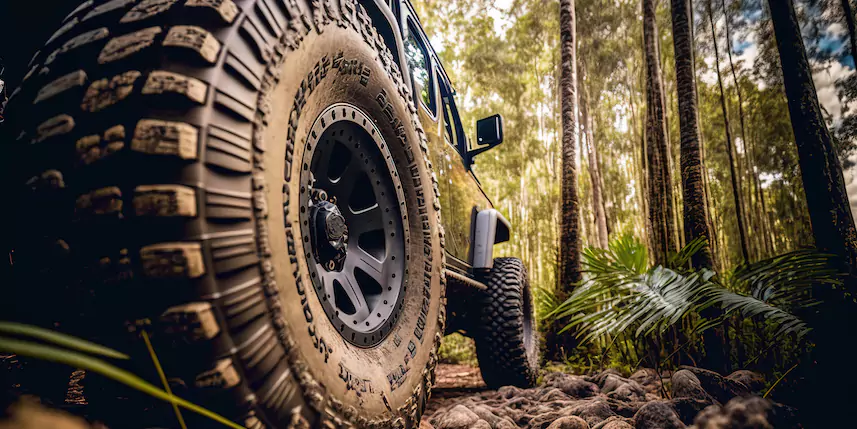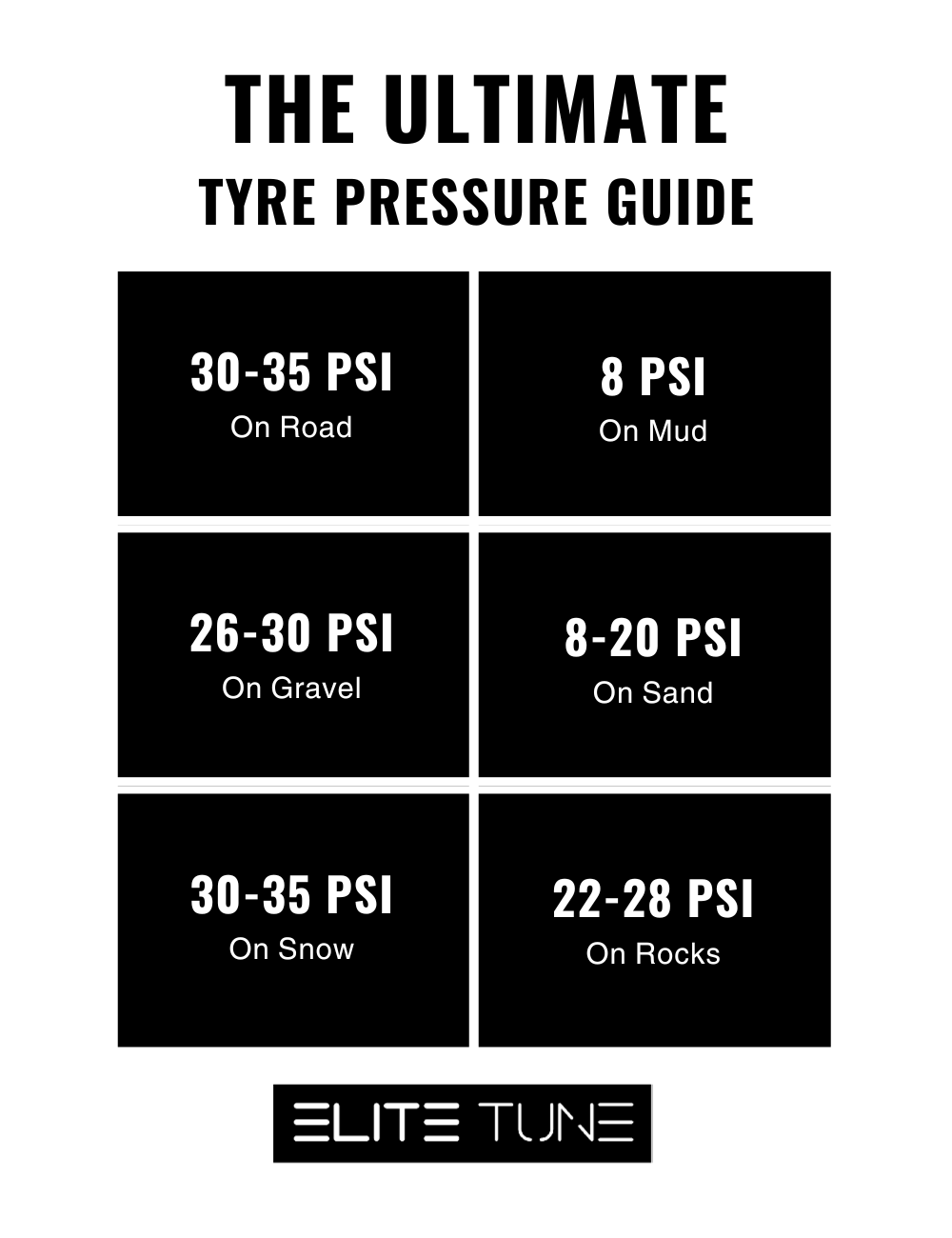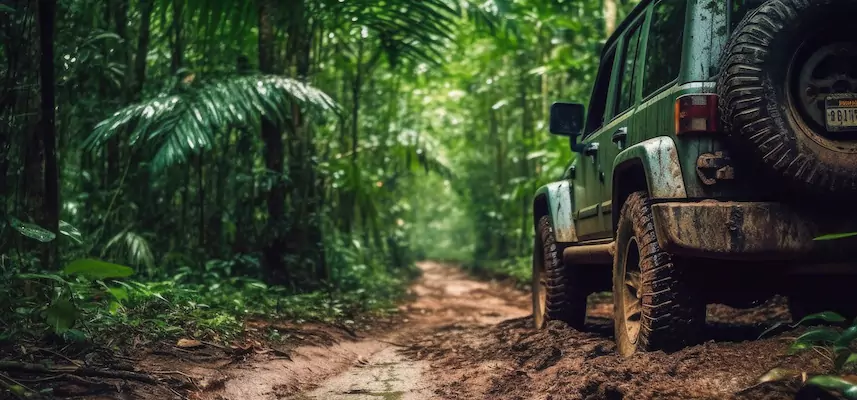The wrong tyre pressure for 4WD endeavours will cause your tyres to wear out faster or leave you stuck in a muddy or sandy area.
Informed by years of experience on all types of terrain, I’ve laid out my expert recommendations for everything from bitumen to boulders and given my top tips for extending the life of your tyres below.
In This Blog
- 4WD tyre pressure chart
- Recommended pressure on road
- Recommended pressure on mud
- Recommended pressure on gravel or dirt
- Recommended pressure on sand
- Recommended pressure on snow
- Recommended pressure on rocks
- Why is using the right pressure important?
- How long do 4WD tyres last?
- What can extend the life of 4WD tyres?
4WD Tyre Pressure Chart
| Terrain | Recommended Tyre Pressure (PSI) |
|---|---|
| Road (Bitumen) | 30-35 |
| Mud | 8-12 |
| Gravel or Dirt | 26-30 |
| Sand | 8-20 |
| Snow | 30-35 |
| Rocks | 22-28 |
As you can see in the above chart, there is no one-size-fits-all answer when it comes to finding the right pressure for your 4WD.
This depends on many variables, such as:
- The conditions
- The terrain and type of road you are driving on
- The condition of the tyres
- The size of the tyres
- The type and condition of the vehicle
- Whether you are towing anything
- The age of the tyres
Depending on the road conditions, your tyres, and the vehicle, you’ll have to adjust the tyre pressure accordingly.
Below I’ve elaborated on my recommendations further and provided helpful insights.
My Top Tyre Pressure Tips
Recommended Pressure on Road (Bitumen) – 30-35 PSI
If you mostly stick to bitumen, you still need to check your tyre pressure. Even on a smooth road, the wrong pressure can decrease safety, reduce fuel efficiency, and shorten your tyre’s lifespan.
For bitumen, I recommend sticking to a pressure of about 30-35 psi. You can use a tyre gauge to regularly check your tyre pressure.
Generally, it’s best to check tyre pressure when your car hasn’t run for several hours. If you’ve just been out cruising around, your tyres are likely heated up a bit. This heat causes the air inside to expand and can give you an inaccurate pressure reading.
Recommended Pressure on Mud – 8-12 PSI
Who doesn’t love barreling their 4WD at full speed into a shallow pit of mud?
While mudding is a blast, it can also leave you stuck in the muck if you aren’t prepared.
Generally, I recommend lowering your tyre pressure to around 8-12 psi if you plan on driving your 4WD through the mud.
This lower pressure will give you the traction you need to maintain control in the mud and decrease your risk of getting stuck and needing someone to come help you recover your vehicle.
Mud is totally unpredictable and inconsistent, so you’ll need to adjust your tyre pressure as needed.
Recommended Pressure on Gravel or Dirt – 26-30 PSI
Heading over a gravel road full of pot holes? Drop the pressure to help deal with those potholes and potentially sharp gravel edges.
My recommendation is to aim for around 26-30 psi.
Recommended Pressure on Sand – 8-20 PSI
Sand is notorious for making it tough to get enough traction. Lowering the pressure increases the amount of tyre surface that touches the sand.
This increased surface area due to lower tyre pressure can help the tyres grip the sand better, improve traction, and increase control.
I always aim for around 20 psi have better traction on the sand while still allowing me to drive carefully and slowly on any paved roads I hit in between sandy areas. While 20psi can work well on packed, firm sand, it’s best to reduce the pressure down to 8 psi if the sand is very soggy and soft.
Read More: Tips for Beach Driving
Recommended Pressure on Snow – 30-35 PSI
Obviously, it’s rare you’ll have to face snow here in Australia. However, it is still important to know the recommended pressure on snow.
Driving on snowy or icy roads can easily result in loss of traction, loss of control, and braking issues.
For snowy conditions, keep tyre pressure around 30 to 35 psi.
Recommended Pressure on Rocks – 22-28 PSI
If you’re driving on rocks, you’ll almost certainly want to drop your tyre pressure.
Lowering the pressure reduces the risk of punctures or damage to your tyres and helps ensure a smoother ride.
Depending on how rocky it is, I aim for pressure between 22-28 psi. Stick closer to 22psi for especially rocky portions.
Why Is Tyre Pressure for 4WD Vehicles Important?
Tyre pressure affects many aspects of your 4WD, including:
- How long the 4WD tyres will last
- How much traction you have when driving on different surfaces
- Overall performance and safety
- Predictability when driving
- Level of control when driving
- Fuel efficiency
- If your ride is jarring and bumpy or smooth and consistent
- Susceptibility to tyre damage
As such, it’s important to be armed with the knowledge you’ll need for a variety of conditions.
How Long Do 4WD Tyres Last?
People are always asking me how long 4WD tyres last.
Unfortunately, there is no set answer since 4WD tyre lifespan depends on a wide range of variables.
However, properly maintained, high-quality 4WD tyres should offer a lifespan of at least 40,000 – 80,000km. Some owners can get up to 100,000km on a set of 4 regularly rotated tyres if they keep their 4WD’s maintenance up to scratch.
Factors Affecting Tyre Wear and Lifespan
- The Weight of the Vehicle — Generally, a heavier vehicle equates to tyres that wear out faster.
- Driving Style — Do you take corners hard? Do you accelerate and brake hard? Do you spin your wheels on rough surfaces? Your tyres will wear out faster than drivers who keep things smooth and steady.
- Off-Roading / Terrain — It’s no surprise that if you do a lot of off-roading, your tyres will wear out faster. Bitumen is far more tyre-friendly than rocky, rough, or sharp terrain. Dune and beach driving are also fairly tyre-friendly.
- Tyre Size — Larger tyres typically last longer.
- Towing — Towing will make your 4WD tyres wear out faster. Any time you are taking off or braking when hauling something, your vehicle and tyres have to work harder. For everything you need to know about towing, check out our Ultimate Towing Guide.
- Tyre Age — Aged tyres, typically five years or older, will start becoming harder and wearing out faster as the rubber deteriorates.
- Tyre Pressure — Pressure that is too low will cause your tyre edges to wear out faster. Pressure that is too high can wear out the centre faster and put your tyres at risk of an irreparable puncture.
- Wheel Alignment — Bad wheel alignment can ruin tyres in record time. We’re talking under 10,000km! Regular wheel alignment is crucial for ensuring your tyres wear properly.
- Non-Driven Wheels — On most 4x4s, the rear wheels are driven more and wear out faster. Some 4x4s balance tyre wear fairly well, but in general the rear wheels wear out faster than the front wheels. This is especially true if you skip engaging your 4WD when off-roading on rough gravel surfaces.
- Tyre Rotation — Tyres that are rotated on a regular basis will last longer. Ideally, you’ll want to have your tyres rotated every 5,000 to 10,000km. It’s also important to incorporate one or two good spare tyres as part of your rotation.
- Vehicle Power — Vehicles with higher torque and power will typically have tyres that wear better. However, if you’re using your 4x4s power to spin your tyres, you’ll wear them out faster.
- Tyre Tread — Tyre tread varies widely, with many people pushing their tyres right until the indicators are visible. And sometimes even longer than that! If your tyre tread is over 50% gone, you greatly increase your chance of a puncture and decrease control and traction.
How to Maximise the Lifespan of Your 4WD Tyres
Here my top tips to get the longest lifespan out of your 4WD tyres:
- Rotate the tyres regularly
- Carry a spare tyre
- Use one or two good spare tyres in your rotation to ensure all tyres are wearing equally
- Keep your driving smooth and steady rather than spinning the wheels on rocky ground or taking corners hard
- Get your wheels aligned as needed
- Regularly inspect the tyres to make sure they are wearing evenly across the tread
- Pay attention to tyre tread and replace tyres as needed
- Get your 4×4 serviced regularly
You’ll also want to ensure you have the right tyre pressure for your vehicle, driving style, and conditions.
Often, this means lowering the pressure. Decreasing the air pressure according to the conditions is an important factor in maximising the lifespan of your 4WD tyres.
Tyres with the right PSI are less susceptible to punctures and damage, especially when rolling over rocks or sharp gravel. When off-roading, lower pressure is key for reducing punctures, gaining traction, and maintaining control.
If you’re driving over muddy or soft areas, dropping the tyres pressure increases surface area. This spreads out the vehicle’s weight and decreases your chance of puncturing a tyre or getting stuck in the mud.
Conclusion
My recommendations are based on years of personal trial and error as well as years of experience specialising in 4WD servicing and modifications.
Using the recommended tyre pressure is crucial to improving your vehicle performance, preventing damage to the tyres, maximising your tyre’s lifespan, and helping you enjoy a safe, smooth ride.
If you are planning an off-roading trip and have questions about what tyre pressure is right for your vehicle, please feel free to get in touch.
Happy off-roading!


